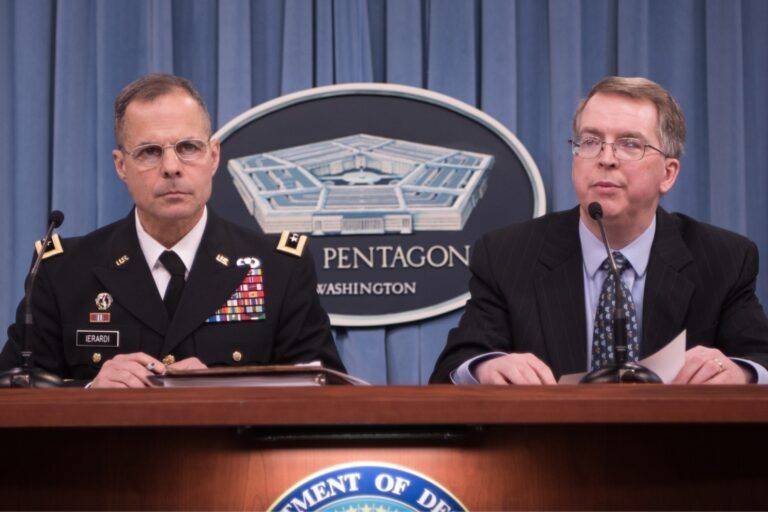The latest in a now long series of developments related to government studies of unidentified aerial phenomena, more commonly known as UFOs, culminated in a new official Statement released by the Department of Defense on Friday. In it, the official establishment of a UAP Task Force was announced, which will investigate possible range incursions within controlled U.S. airspace by aircraft or objects of unknown provenance.
“On Aug. 4, 2020, Deputy Secretary of Defense David L. Norquist approved the establishment of an Unidentified Aerial Phenomena (UAP) Task Force (UAPTF),” the statement reads. “The Department of the Navy, under the cognizance of the Office of the Under Secretary of Defense for Intelligence and Security, will lead the UAPTF.”
The DoD statement explains that the UAPTF will focus on improving the military’s understanding and insights into the question over UAP origins, outlining the task force’s mission as being “to detect, analyze and catalog UAPs that could potentially pose a threat to U.S. national security.”
This is not the first we have heard about the DoD’s UAP Task Force. Weeks ago, a report by the Senate Intelligence Committee discussed its support for the task force, noting that it operated out of the Office of Naval Intelligence. However, this raises an interesting question which has remained a point of confusion: does the task force already exist, or was it newly established on August 4th, as the DoD’s most recent official statement would appear to indicate?
As noted previously by this columnist, what appears to have been the first reference to this DoD UFO investigative body as a “task force” appeared in a statement provided by Pentagon spokeswoman Susan Gough to researcher Roger Glassel, in which she noted that, “Documented reports of sightings by military personnel form the basis for the investigation process,” and that the “investigation of UAP sightings by the multi-agency task force is ongoing.”
Gough’s statement, which dates back to May, certainly made it sound as if the UAP Task Force weren’t a new thing. Gough also noted in her statement to Glassel that on account of the fact that the majority of these sightings and potential incursions by unidentified aircraft are being logged by Navy pilots, the Department of the Navy will be overseeing the operation.
“Unfortunately, I cannot speak officially as to the current nature of the UAP Task Force, but I have every indication to believe that it is up and running,” said Luis Elizondo, former head of the DoD’s Advanced Aerospace Thread Identification Program (AATIP), in a quote that appeared in a Motherboard article in July. Elizondo further stated that he believed the UAP Task Force “is executing the mission consistent with the fundamental principles of AATIP.”
So it would appear that the UAP Task Force (or at least some version of it) has existed for some time now already. Another question though is, why a task force, what precisely does that mean, and what exact roles does a task force perform?
The fact that the UAP task force is operated out of the Department of the Navy is interesting in itself, since there is actually a bit of history behind this. In fact, the Navy was the first branch of the military to ever use the term “task force,” which was defined as a unit or organization that looks at a single defined task or activity. In more recent weeks, we have seen the term used in relation to such things as the White House Coronavirus Task Force, so obviously the term is applied more broadly in modern usage, having since been adopted as part of the terminology used by NATO. In the case of the UAP Task Force, it is actually more likely that this name is meant in the more general sense, although the Navy will oversee the operation.
“As DOD has stated previously, the safety of our personnel and the security of our operations are of paramount concern,” Friday’s statement read. “The Department of Defense and the military departments take any incursions by unauthorized aircraft into our training ranges or designated airspace very seriously and examine each report. This includes examinations of incursions that are initially reported as UAP when the observer cannot immediately identify what he or she is observing. “
The final portion of the DoD’s brief statement is important, since it strikes at the very heart of what UAP is: unidentified. Of course, in some cases there will be reports made by pilots and other military personnel that involved far more mundane things than the object that was reported by Commander David Fravor at the time of the now famous 2004 U.S.S. Nimitz UFO Incident. As has been suggested of certain more recent Navy encounters with unidentified aircraft, as detailed in a May 26, 2019 New York Times article, some of the objects described by pilots bear resemblance to patent images for a variety of airborne radar reflectors, as suggested by Tyler Rogoway of The Warzone.
The exact nature of such objects, the likes of which were described by pilot Ryan Graves, remains undetermined, although subsequent reporting by The Warzone and the New York Times detailed U.S. Navy Hazard Reports detailing several incidents where objects encountered by Navy pilots in controlled air space over coastal regions of the Eastern United States were subsequently identified as balloons and drones in several instances.
“I have no doubt that military intelligence services around the world have always been interested in ‘UFO reports’,” space historian James Oberg recently told columnist Leonard David, writing for Space.com, adding “whether or not a real ‘unexplainable’ phenomenon is behind a few of them.”
The predominant opinion among skeptically inclined aerospace enthusiasts is that the objects in the three Navy videos purporting to show unidentified aerial phenomena are in reality just distant jets. In the case of the video captured by pilot Chad Underwood in 2004 shortly after Commander Fravor’s encounter, the question remains as to why no transponder or other readily identifiable characteristics of a commercial jet would have been discernible at that time. One suggestion is that this could have been a small aircraft involved in illicit drug trade, which might account for the absence of a transponder. However, if this were the case, it raises additional concerns about the prevalence of such traffic along coastal regions, and particularly within 20 miles of active military training operations.
Perhaps these, and other questions related to unusual objects encountered by Navy pilots will be answered with the help of the forthcoming UAP Task Force, and the report it has been requested to produce by the Senate Intelligence Committee. Then again, if previous efforts by civilian organizations at obtaining information from government about such incidents has been any indication, it might be wise not to hold our breath.

